Eyelid Surgery
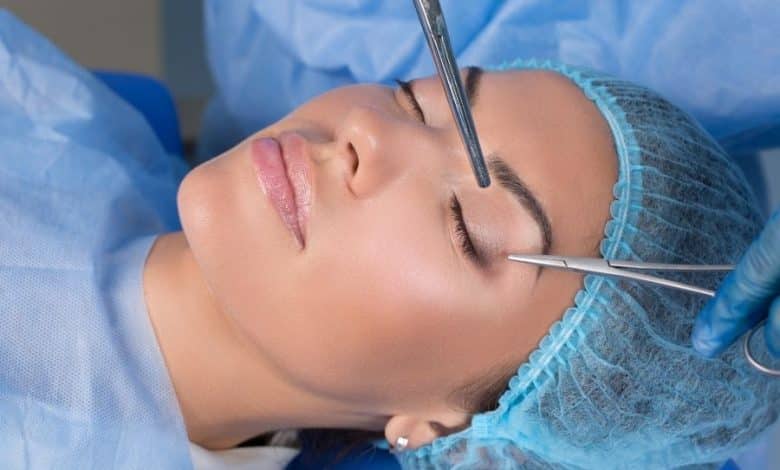
Eyelid surgery is an aesthetic surgical procedure performed for reasons such as sagging, loosening or bagging of the eyelids. This process is also preferred for those who want to achieve a younger and fresher appearance.
Eyelid surgery is usually performed under local anesthesia and the procedure takes about 1-2 hours. During the procedure, excess fat, muscle or skin is removed and the eyelids look younger and firmer. The healing process takes about 1-2 weeks and swelling, bruising and pain may occur in the eye area after the procedure. However, these symptoms subside over time and the time to return to normal activities may be short.
As with any surgical procedure, such as eyelid surgery, there are risks. These may include infection, bleeding, wound healing problems, reactions to anesthesia, dry eyes or loss of vision. Therefore, before having eyelid surgery, it is important to have a detailed discussion with a plastic surgeon and carefully consider the risks and benefits.
Eyelid surgery is an effective option for removing sagging and bagging on the eyelids and can provide the patient with a younger and more dynamic appearance. However, it is important that it is applied with the right indications in the right patients and the expectations of the person should be realistic.
İçindekiler
What Is Droopy Eyelid?
A droopy eyelid is a condition in which the upper eyelids droop or loosen more than normal. The eyelids are an important part of the eye and have important tasks such as protecting the eye, moisturizing it and cleaning the surface of the eye. A droopy eyelid can make it difficult to perform these functions and cause vision problems.
A droopy eyelid can be caused by a variety of causes, including the aging process, weakening or damage of the eyelid muscles, genetic factors, eye infections or diseases. A droopy eyelid can also occur due to other health problems or medications used.
Symptoms of droopy eyelids may include drooping or loosening of the eyelids, narrowing of the field of vision, eyestrain, itching, burning or redness. It is important to treat droopy eyelids when it causes vision problems.
Treatment is usually done as eyelid surgery. This procedure is accomplished by removing excess tissue or fat or reorganizing the eyelid muscles. If the droopy eyelid does not cause vision problems, it is not necessary to be treated, but if the person has aesthetic concerns, surgical intervention can be performed.
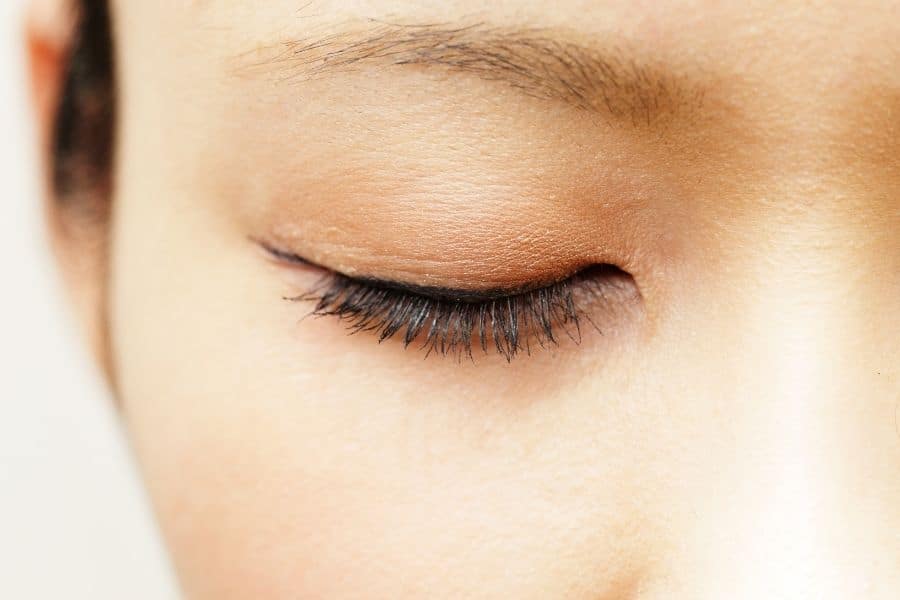
What Are the Symptoms of Drooping Eyelids?
Eyelid droop symptoms are lower eyelids than their normal position due to weakening or drooping of the eyelid muscles. Symptoms of droopy eyelids may include:
- Drooping or drooping of the eyelids: The eyelids may droop lower or forward than their normal position. This may cause you to have difficulty keeping your eyes open.
- Narrowing of the field of vision: When the eyelids are not in their normal position, the area in front of your eyes may narrow. This can be especially noticeable when looking up or forward.
- Feeling tired in the eyes: When the eyelids are low, your eyes are more likely to feel tired or sore.
- Eyelid pulling: Some people can see better by pulling their eyelids or raising their eyebrows while trying to keep their eyes open due to drooping eyelids.
- Double vision: A droopy eyelid can cause problems with double vision or blurred vision because you have trouble keeping your eyes open.
- Dry eyes: Eyelids can block the sebaceous glands that moisten your eyes. This can dry out your eyes and create a feeling of discomfort.

What Causes Droopy Eyelids?
Eyelid drooping may occur due to weakening or relaxation of the eyelid muscles. It can also be a congenital condition.
The aging process can cause droopy eyelids due to factors such as weakening of the eyelid muscles or loss of elasticity. This condition is usually seen as a drooping upper eyelid and can limit the visual field.
A droopy eyelid can sometimes occur when we are tired, sleepless or stressed. In addition, some health problems, eye injuries, eye infections, eye tumors or nerve damage can also cause droopy eyelids.
Droopy eyelids can be uncomfortable and cause vision problems. Therefore, it is recommended to consult an ophthalmologist when symptoms appear.
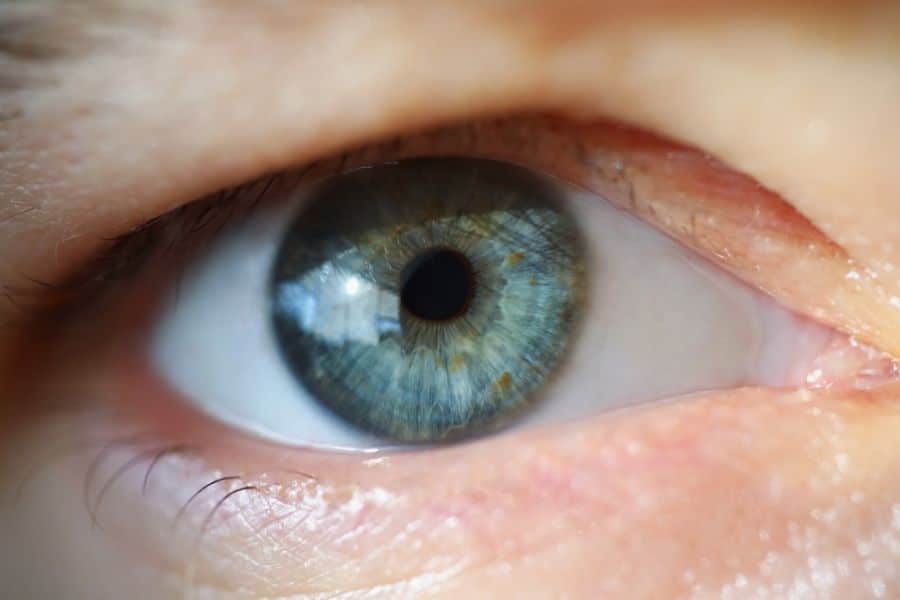
How Is the Diagnosis of Droopy Eyelid Made?
The diagnosis of droopy eyelids is made by an ophthalmologist with a physical examination. The physician performs the necessary investigations for touching, blinking, evaluation of tear secretion and diagnosis of droopy eyelids by examination. An open eye exam and tear test may also be done. In addition to drooping eyelids, there are also tests used to diagnose eyelid abnormalities such as ptosis or entropion.
Does Drooping Eyelid Affect Vision?
A droopy eyelid can affect the eyesight of the eye. This condition is caused by the lids on the corners of the eye not being closed adequately. This can cause dust, air currents, or other liquids to get between the eyes or inside the eye. At the same time, droopy eyelids can cause a slight redness that can damage the pupil of the eye. This can reduce the eye’s ability to see. In the treatment of droopy eyelids, a surgical intervention with the healing feature of the eyelid or a support attached to the eyelid can be applied.
What are the Treatment Methods for Droopy Eyelids?
There are many treatment methods in the treatment of droopy eyelids:
1. Eyelid Aesthetics: This treatment aims to improve the aesthetic appearance of the droopy eyelid. A surgical procedure, such as lifting and reshaping the eyelid, may be required.
2. Botox: Botulinum toxin is used to relax the muscles of the eyelid, thus allowing the lids to stay in a higher place. This treatment can provide short- or medium-term effects.
3. Eyelid lift: A surgical procedure may be required to lift the eyelid. This operation can be done to improve the location of the lids and reduce the lines and wrinkles under the eyes.
4. Strengthening the area around the eyes: Strengthening the area around the eyes is an important factor in the treatment of droopy eyelids. This can be done using products such as creams or serums.
5. Eyelid lifter: Eyelid lifter products can be used to lift and support the eyelid. These products can make the eyelid lift and hold in place.
How is Eyelid Surgery Performed?
Eyelid drooping surgery (blepharoplasty) is a surgical procedure to correct upper or lower eyelid sagging caused by weakening or relaxation of the eyelid muscles. The procedure is usually done under local anesthesia and takes about 1-2 hours.
During surgery, excess skin, muscle and fat tissue on the eyelid are removed or rearranged. For lower eyelid drooping, incisions are usually made from the inside of the conjunctiva or from the lower eyelid margin, while incisions are made from the upper eyelid crease for upper eyelid drooping.
Next, the eyelid muscles are sutured and the incisions are closed. Post-operatively, patients may experience swelling, bruising and mild pain for a few days. The healing process takes about 1-2 weeks and during this time it is recommended that patients rest their eyes and avoid certain activities.
When performed correctly, eyelid drooping surgery usually gives successful results and helps patients to expand their visual field and achieve a younger and more dynamic appearance. However, like any surgical procedure, droopy eyelid surgery can involve some risks and side effects. Therefore, it is recommended to consult an ophthalmologist before surgery.
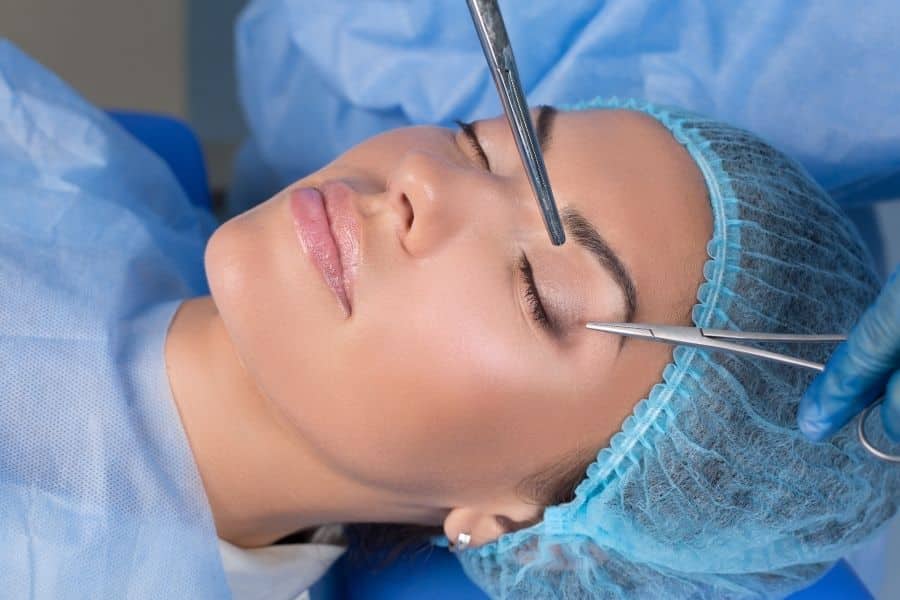
What Are the Types of Lower Eyelid Surgery?
Eyelid drooping surgery (blepharoplasty) can be performed using several different techniques to correct sagging lower and upper eyelids. The most commonly used droopy eyelid surgery types are:
- Upper Eyelid Surgery: This procedure is performed to correct the sagging of the upper eyelid. Usually, incisions are made in the upper eyelid crease and saggy skin, muscle, and adipose tissue are removed or rearranged.
- Lower Eyelid Surgery: This procedure is performed to correct the sagging of the lower eyelid. Incisions are made at the lower eyelid margin or through the conjunctiva, and saggy skin, muscle, and adipose tissue are removed or rearranged.
- Transconjunctival Blepharoplasty: This procedure is performed only to remove the fatty tissue in the lower eyelid. The incisions are made over the conjunctival tissue in the lower eyelid, thus reducing visible scars from the outside.
- Transblepharoplasty Lower Eyelid Tightening: This procedure is performed to correct sagging lower eyelids and can be applied together with transconjunctival blepharoplasty. The lower eyelid muscles are tightened and the surrounding tissues are reshaped.
- Combined Upper and Lower Eyelid Surgery: This procedure is performed to correct sagging in both the upper and lower eyelids. While incisions are made in the upper eyelid crease, incisions are made on the lower eyelid margin or inside the conjunctiva.
Eyelid drooping surgery is customized to each patient’s condition and needs. Therefore, the selection of the most appropriate surgical method should be done together with your doctor.
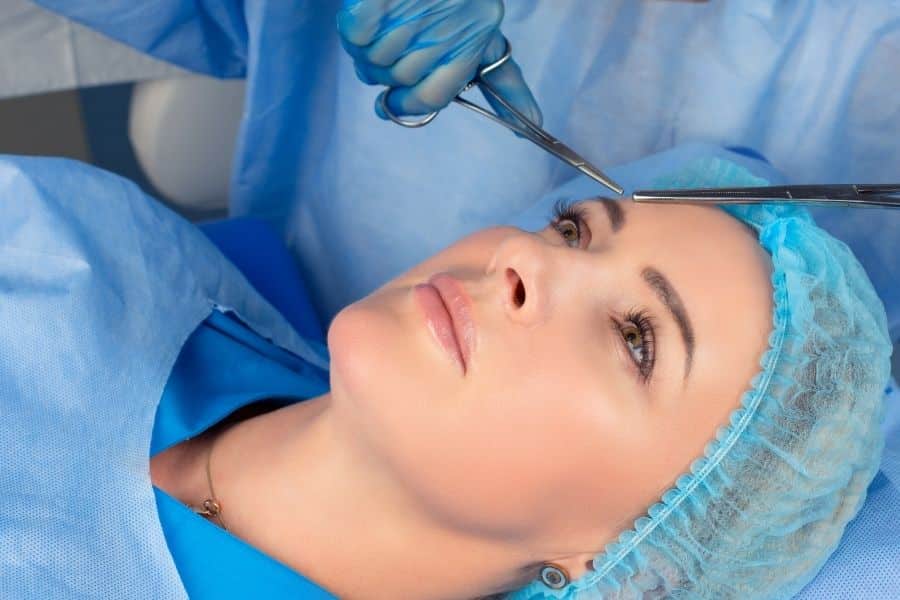
What should be considered before and after drooping eyelid surgery?
Things to consider before and after eyelid drooping surgery are as follows:
PRE:
- If you are a smoker, you need to quit a few weeks before the surgery. Smoking can negatively affect the healing process.
- You should not use aspirin, ibuprofen and similar blood thinners in the few days before the surgery. They can increase the risk of bleeding.
- Be examined for the last time before surgery and follow your doctor’s recommendations.
- Prepare in advance the materials you will need after the surgery, such as ice packs, sterile cotton and eye drops.
- Prefer comfortable and loose clothing on the day of surgery.
POST:
- You may need to wear glasses or bandages to protect your eyes immediately after surgery.
- During the first few days, try to rest in a way that does not strain your eyes. Limit reading, watching TV, and computer use.
- Do not rub your eyes in any way, and call your doctor right away if you experience redness, itching, or pain.
- Use the eye drops recommended by your doctor regularly.
- Post-operative swelling and bruising are normal. You can reduce swelling and bruising with cold compresses such as an ice pack.
- Avoid heavy physical activities for the first few weeks. Also, stay away from sports where you can hit your face.
- Follow your doctor’s recommended follow-up appointments during the recovery period and have regular check-ups.
The recovery process after drooping eyelid surgery may be different for each patient, but it is important that you follow the above recommendations and keep in regular contact with your doctor.
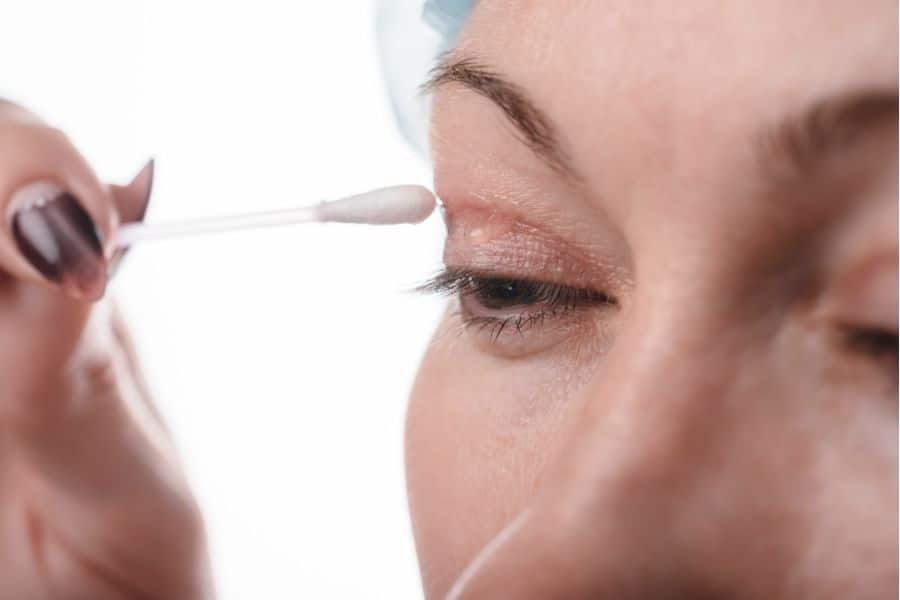
How long does droopy eyelid surgery last?
The effect of droopy eyelid surgery is usually permanent. The eyelid, which is corrected after the surgery, is usually held up permanently and the sagging of the eyelid is removed. However, there is a possibility of drooping again due to the loss of elasticity in the eyelid over the years after the surgery. In addition, the surgical procedure and healing process performed on the eyelid in the postoperative period is different for each patient and the duration of the effect may vary.
Being careful during the postoperative recovery period and following the doctor’s recommendations can positively affect the postoperative effect period. In addition, maintaining a healthy lifestyle, regular visits to the doctor, and avoiding activities that may damage the eyelid can increase the duration of the postoperative effect.
Low Eyelid Surgery Prices
The prices of droopy eyelid surgery may vary according to the country, hospital, surgeon and the surgical technique applied. In addition, other factors such as length of hospital stay and materials used can also affect prices. In general, surgery prices may be more affordable if they are covered by private health insurance.
However, in general, droopy eyelid surgery prices in the US can range from $2,000 to $5,000. In Turkey, these prices can be between 5,000 and 10,000 TL on average. The variability of prices depends on factors such as length of stay in hospital, surgical technique, materials used and general health status of the patient.
There is also the opportunity to have surgery by traveling abroad, which is known as health tourism. However, it is important to be careful in health tourism and to do research in the selection of hospitals and surgeons.




